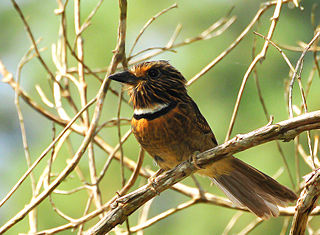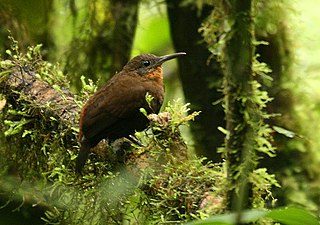
The plain-brown woodcreeper, is a sub-oscine passerine bird in subfamily Dendrocolaptinae of the ovenbird family Furnariidae. It is found in the tropical New World from Honduras through South America to central Brazil and in Trinidad and Tobago.

The two-banded puffbird is a species of near-passerine bird in the family Bucconidae, the puffbirds, nunlets, and nunbirds. It is found in Colombia and Venezuela.

The lineated woodpecker is a very large woodpecker which is a resident breeding bird from southern Mexico to northern Argentina and on Trinidad in the Caribbean.

The golden-olive woodpecker is a species of bird in subfamily Picinae of the woodpecker family Picidae. It is found from Mexico south and east through Panama, in every mainland South American country except Chile, Paraguay, and Uruguay, and in Trinidad and Tobago.

The western emerald is a species of hummingbird in the "emeralds", tribe Trochilini of subfamily Trochilinae. It is found in Colombia and Ecuador.

The amethyst-throated sunangel is a species of hummingbird in the "coquettes", tribe Lesbiini of subfamily Lesbiinae. It is found in Bolivia, Ecuador, and Peru.

The chestnut-capped puffbird is a species of bird in the family Bucconidae, the puffbirds, nunlets, and nunbirds. It is found in Bolivia, Brazil, Colombia, Ecuador, Peru, and Venezuela.

The sooty-capped puffbird is a species of bird in the family Bucconidae, the puffbirds, nunlets, and nunbirds. It is endemic to Colombia.

The black-streaked puffbird is a species of near-passerine bird in the family Bucconidae, the puffbirds, nunlets, and nunbirds. It is found in Bolivia, Colombia, Ecuador, and Peru.

The crescent-chested puffbird is a species of near-passerine bird in the family Bucconidae, the puffbirds, nunlets, and nunbirds. It is endemic to Brazil.

The chestnut-headed crake is a species of bird in subfamily Rallinae of family Rallidae, the rails, gallinules, and coots. It is found in Bolivia, Brazil, Colombia, Ecuador, and Peru.

The russet-crowned crake is a species of bird in subfamily Rallinae of family Rallidae, the rails, gallinules, and coots. It is found in Bolivia, Brazil, Colombia, Ecuador, the Guianas, Paraguay, Peru, and Venezuela.

The ash-throated crake is a species of bird in the subfamily Rallinae of the rail, crake, and coot family Rallidae. It is found in every mainland South American country except Chile.

Longuemare's sunangel is a species of hummingbird in the "coquettes", tribe Lesbiini of subfamily Lesbiinae. It is found in Colombia and Venezuela.

The gartered trogon, also known as the northern violaceous trogon, is a bird in the family Trogonidae, the quetzals and trogons. It is found in Mexico, all of Central America, and Colombia, Ecuador, Peru, and Venezuela.

The citron-throated toucan is a near-passerine bird in the family Ramphastidae, the toucans, toucanets, and aracaris. It is found in Colombia and Venezuela.

The isthmian wren is a species of bird in the family Troglodytidae. It is found in Costa Rica and Panama.

The white-throated toucanet or greyish-throated toucanet is a near-passerine bird in the toucan family Ramphastidae. It is found in Colombia, Ecuador, and Venezuela.

The western striolated puffbird is a species of bird in the family Bucconidae, the puffbirds, nunlets, and nunbirds. It is found in Bolivia, Brazil, Colombia, Ecuador, and Peru.

The dusky leaftosser or South American leaftosser is a bird in subfamily Sclerurinae, the leaftossers and miners, of the ovenbird family Furnariidae. It is found in Bolivia, Brazil, Colombia, Ecuador, French Giana, Guyana, Panama, Peru, Suriname, and Venezuela.























